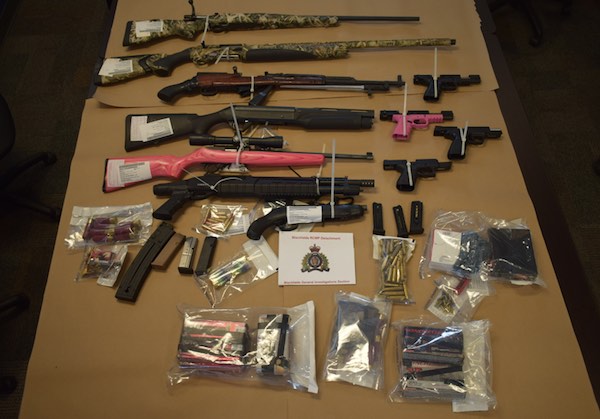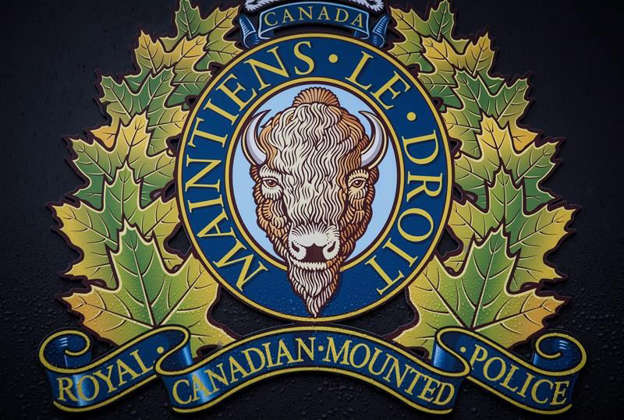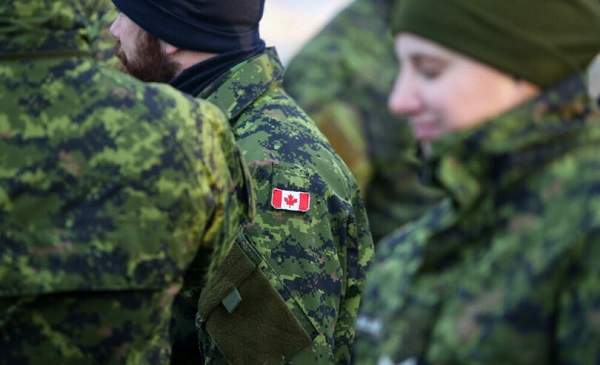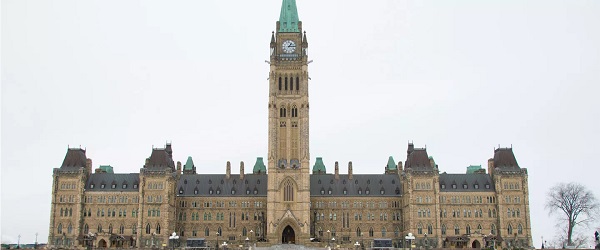Alberta
RCMP crack firearms trafficking operation based in Blackfalds

From the Blackfalds RCMP
Blackfalds RCMP – Multi agency attack on firearms trafficking
A comprehensive investigation was initiated in January, and saw at least 11 different partnering detachments, units and agencies collaborating to stop an organized firearms straw buying/trafficking operation.
The investigation was launched by Blackfalds RCMP after receiving intelligence about the possibility of the trafficking. Extensive evidence had to be gathered which included the engagement of firearms partners; the Chief Firearms Officer, NWEST, Red Deer ALERT and Edmonton Police Service’s Firearms Investigation Unit. These units were able to provide expertise related to the dynamics of straw purchasing and trafficking.
Three suspects were identified and targeted in the ongoing investigation. On Feb. 12, search warrants were conducted at residences in both Red Deer and Blackfalds. Because there were two different locations, and given the nature of the searches, Blackfalds, Red Deer, Sylvan Lake, Innisfail, Ponoka General Investigation Section Units and Red Deer Crime Reduction Team all provided assistance. The RCMP Police Dog Services and Emergency Response Team were also on hand to ensure police and public safety.
Three adults were taken into custody. During the execution of the search warrant, a loaded Glock .22 pistol was located with the three adults. 10 firearms and ammunition were seized from the residences. Some of the firearms were loaded, and had serial numbers tampered with. Continuing investigation led the RCMP to determine other firearms were purchased. The Blackfalds RCMP anticipate seizing two more pistols from a Calgary business.
David Jason Masyk (39), Jason Paul Lafferty (48) and Jennifer Lynn McCagherty (29) were all charged criminally on Feb. 13 related to firearms / firearms trafficking offences.
Lafferty is facing 25 charges, including four counts of firearms possession contrary to prohibition order. Masyk is facing 10 charges, including three counts of Weapons Trafficking and four counts of Weapons possession for the purpose of trafficking and McCagherty is facing 19 charges, including 10 counts of unauthorized possession of a firearm.
Judicial Interim Release hearings were held. Lafferty did not speak to bail and was remanded into custody until Feb. 17, 2021. Masyk and McCagherty were both released and are set to appear in Red Deer Provincial court on March 17, 2021.
Alberta
Integrated Border Enforcement Team makes 189 kg cocaine bust at Coutts port of entry

News release from Alberta RCMP
Canada Border Services Agency (CBSA) officers, working with the Integrated Border Enforcement Team (IBET) in Alberta, a joint force operation between the RCMP Federal Policing Northwest Region, CBSA and Calgary Police Service, seized 189 kg of cocaine following a secondary examination of a commercial truck seeking entry at the Coutts port of entry on Nov. 13, 2024. The drugs have an approximate wholesale value of $2 million.
“The safety and security of Canadians is the RCMP Federal Policing Northwest Region’s top priority. With the support of various law enforcement agencies, we’ve successfully prevented harmful drugs from entering Canada and harming our communities.
- Supt. Sean Boser, Officer in Charge of Federal Serious Organized Crime and Border Integrity – Alberta, RCMP Federal Policing Northwest Region
“I want to commend our CBSA officers who prevent illegal narcotics from breaching our borders and disrupt crime networks. In cooperation with our law enforcement partners, the RCMP and the Calgary Police Service, this significant seizure serves as another example of how Canada’s borders are being secured and drugs are kept off our streets.”
- Ben Tame, Director, Southern Alberta and Southern Saskatchewan District, Canada Border Services Agency
“Our efforts to combat drug trafficking rely heavily on working closely with our partner law enforcement agencies, including the CBSA and RCMP. This is a significant seizure that undoubtedly had the potential to cause serious damage to our community.”
- Supt. Jeff Bell, Criminal Operations & Intelligence Division, Calgary Police Service
IBET’s mandate is to enhance border integrity and security along the shared border, between designated ports of entry, by identifying, investigating and interdicting persons, organizations and goods that are involved in criminal activities.
All partners are engaged in the ongoing criminal investigation.
Alberta
Alberta government must do more to avoid red ink

From the Fraser Institute
By Tegan Hill
As Albertans look toward a new year, it’s worth reviewing the state of provincial finances. When delivering news last month of a projected $4.6 billion budget surplus for fiscal year 2024/25, the Smith government simultaneously warned Albertans that a budget deficit could be looming. Confused? A $4.6 billion budget surplus sounds like good news—but not when its on the back of historically high (and incredibly volatile) resource revenue.
In just the last 10 years, resource revenue, which includes oil and gas royalties, has ranged from a low of $3.4 billion in 2015/16 (inflation-adjusted) to a high of $26.1 billion in 2022/23. Inflation-adjusted resource revenue is projected to be relatively high in historical terms this fiscal year at $19.8 billion.
Resource revenue volatility is not in and of itself a problem. The problem is that provincial governments tend to increase spending when resource revenue is high, but do not similarly reduce spending when resource revenue declines.
Overall, in Alberta, a $1 increase in inflation-adjusted per-person resource revenue is associated with an estimated 56-cent increase in program spending the following fiscal year, but a decline in resource revenue is not similarly associated with a reduction in program spending. Over time, this pattern has contributed to historically high levels of government spending that exceed ongoing stable levels of government revenue.
And while the Smith government has shown some restraint, spending levels remain significantly higher than reliable ongoing levels of government revenue. Put simply, unpredictable resource revenue continues to help fund Alberta’s spending—and when resource revenues inevitably fall, Alberta is at high risk of plummeting into a deficit.
Indeed, Finance Minister Nate Horner continues to emphasize that we are “living in extremely volatile times” and warning that if oil prices fall below $70.00 per barrel a budget deficit is “very likely.” According to recent forecasts, the price of oil may hit $66.00 per barrel in 2025.
To avoid this fate, the Alberta government must do more to rein in spending. Fortunately, there’s plenty of options.
For example, the government spends billions in subsidies (a.k.a. corporate welfare) to select industries and businesses every year. A significant body of research shows these subsidies fail to generate widespread economic benefits. Eliminating this corporate welfare, which would generate significant savings in the budget, is a good place to start.
If the Smith government fails to rein in spending, and Alberta incurs a budget deficit, it will only mean more government debt on the backs of Albertans. And with Albertans already paying approximately $650 each in provincial government debt interest each year, that’s something Albertans simply can’t afford.
With a new year set to begin, the Smith government continues to warn of a budget deficit. But rather than simply prepare Albertans for more debt accumulation—financed by their tax dollars—the government should do more to avoid red ink. That means cutting wasteful government spending.

Tegan Hill
Director, Alberta Policy, Fraser Institute
-

 Health20 hours ago
Health20 hours agoTrump doubles down on using RFK Jr. to study possible link between vaccines and autism
-

 Crime19 hours ago
Crime19 hours agoBiden’s ‘preemptive pardons’ would set ‘dangerous’ precedent, constitutional scholar warns
-

 International2 days ago
International2 days agoBombshell report shows FBI had ‘informants’ in Washington, DC on January 6
-

 Business21 hours ago
Business21 hours agoCanada needs to get serious about securing its border
-

 Business2 days ago
Business2 days agoFor the record—former finance minister did not keep Canada’s ‘fiscal powder dry’
-

 Business1 day ago
Business1 day agoOut-Trumping Trump: A Mission Without a Win
-

 Business22 hours ago
Business22 hours agoCanadians face massive uncertainly and turbulence in 2025
-

 armed forces2 days ago
armed forces2 days agoCanadian military deployed ‘gender advisors’ to Ukraine, Haiti at taxpayers’ expense






